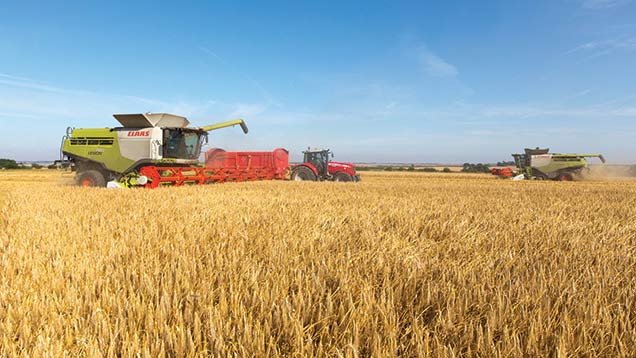Call for realistic contract farming terms
 ©Tim Scrivener
©Tim Scrivener Farmers and contractors need to re-examine their contract farming agreements (CFAs) to check they are realistic and sustainable, warn advisers.
“With a forecast drop in the value of the Basic Payment, environmental stewardship incomes coming to an end and commodity markets depressed, the atmosphere now is very different to the one in which many agreements were put together,” said Robert Gazely, an associate with Strutt & Parker.
Since 2012, farmer’s retentions or first charges on CFAs run by the firm were higher than the contractor’s basic charge, with many tenders and renewals still occurring on this basis, said Mr Gazely.
See also: Business Clinic – contract farming insurance advice
However both the contractor’s charge and farmer’s first charge must be pitched at a level to allow a divisible surplus to be achieved, he said.
“There is nothing more depressing than looking at harvest accounts which don’t make a divisible surplus,” he said, acknowledging that some would struggle in 2015 unless they could get a premium for output.
The level of farmer’s retention must be sustainable and would depend on factors including soil quality, field size, yield potential and grain storage, he said.
“If all of these are favourable, the potential for a higher gross margin – meeting the first charge with a healthy divisible surplus – is realistic. To the contrary, both the process and relationship can soon become negative if this is not the case.”
Similarly, the contractor’s first charge must be correctly pitched – too high and the relationship could sour; too low and their commitment and ability to proactively and efficiently operate on the land will be questioned.
At Bidwells, farm business consultant Ian Ashbridge also stressed that realistic prior charges were essential to CFAs working well.
Agreements must guarantee the contractor’s basic payment to cover contracting operational costs, however if agreements made a loss, then the farmer’s first charge was at risk, demonstrating that the farmer party was taking a trading risk.
“Fuel costs may have come down but labour and depreciation costs have risen significantly – contractors need to be reimbursed for the cost of their work so they don’t lose out,” said Mr Ashbridge.
The prospects for 2015 pointed to a drop in divisible surplus (also described as rateable profit in some agreements).
Results from Bidwells show that the gap between contractor and farmer total returns has been narrowing, with returns from the 2014 harvest dipping slightly for both parties (see graph).
Prior charges for both parties rose by about £12/ha in 2014 but the divisible surplus fell, bringing a total return of £376/ha for the farmer and £420/ha to the contractor.
These results come from about 80 farms on 15,000ha, with an average size of about 250ha but ranging from 60ha to more than 1,000ha. More than 80% of the area is in combinable crops, with the balance in sugar beet, potatoes and some higher value salad and vegetable crops.
Picking a good contractor was key, as was transparency throughout the operation of the agreement, said Mr Ashbridge. For example, having a weighbridge helped to demonstrate what had gone into store. It was also crucial to have good management accounts on which to base decisions.
The longevity of some CFA relationships which had been running for 20-years or longer with the same parties pointed to the fact that fair agreements were achievable, he added.
|
Contract farming results |
||
|
Harvest 2013 (£/ha) |
Harvest 2014 (£/ha) |
|
|
Total receipts (including SFP) |
1368 |
1404 |
|
Less variable costs |
454 |
478 |
|
Fixed costs |
89 |
89 |
|
Contractor’s basic charge |
246 |
264 |
|
Net margin |
579 |
573 |
|
Farmer’s retention |
298 |
293 |
|
Divisible surplus |
281 |
280 |
|
Total return (farmer) |
432 (of which 134 = share of divisible surplus) |
449 (of which 156 = share of divisible surplus) |
|
Total return (contractor) |
389 (of which 143 = share of divisible surplus) |
383 (of which 119 = share of divisible surplus) |
|
Strutt & Parker’s contract farming results for 2014, covering more than 12,000ha across the UK, show total income rose by £36/ha to £1,404/ha, with some outstanding yields helping to offset lower commodity prices. Variable costs rose by £24/ha due partly to a higher spend on fungicides, because of high disease pressure. Fixed costs were the same as in 2013, resulting in an average net margin, after the contractor’s basic charge, of £573/ha. The contractor’s basic charge rose by £18/ha in 2014, to an average of £264/ha overall, and the farmer’s first charge decreased by £5/ha. Total returns were in the favour of the farmer, who received an average £449/ha from the agreements, a 4% rise on 2013. The contractor’s total income averaged £383/ha, a fall of £6/ha on the previous year. Mr Gazely said this was also down to a shift in the way the divisible surplus was split. This moved from a first tier of 65:35 in the contractor’s favour and a second tier of 55:45 in the farmer’s favour in 2013, to a first tier of 60:40 (in contractor’s favour) and a second tier 60:40 (in farmer’s favour) in 2014. |
||
|
Source: Strutt & Parker. Based on combinable crop farms with rotations including wheat, barley, oilseed rape, peas and beans. About 10% of the farms have some specialist cropping including potatoes, carrots and parsnips. |
||
For more news, photos, video and information on the Cereals event see our Cereals 2015 page

